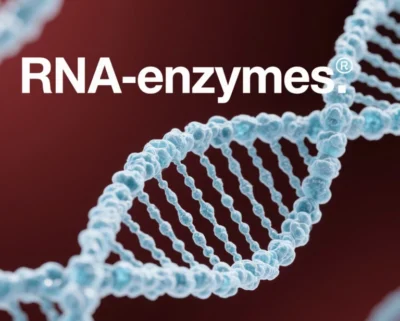
Comprehensive Guide to RNA Enzymes: Classification and Mechanisms
RNA enzymes are biomacromolecules with catalytic functions, directly involved in or regulating RNA-related biochemical reactions. They are broadly classified into two categories based on molecular composition and activity:
I. Ribozymes: Catalytic RNA Molecules
Ribozymes are RNA molecules that catalyze specific biochemical reactions through unique three-dimensional structures, challenging the traditional notion that all enzymes are proteins. They rely on base pairing, metal ion coordination, and structural dynamics for catalysis.
1. Key Discoveries and Significance
- Breakthrough: In 1982, Cech discovered self-splicing introns in Tetrahymena rRNA, while Altman identified the catalytic RNA component of RNase P. Both won the 1989 Nobel Prize in Chemistry.
- Evolutionary Insight: Ribozymes support the RNA World Hypothesis, suggesting RNA served dual roles (genetic and catalytic) in early life.
2. Classification and Mechanisms
| Type | Structure | Catalytic Reaction | Biological Role | Example |
|---|---|---|---|---|
| Small Ribozymes | 30–150 nt, compact folding | Site-specific RNA cleavage | Viral genome processing | Hammerhead ribozyme |
| Self-Splicing Introns | 400+ nt, complex topology | Intron excision & exon ligation | Eukaryotic pre-mRNA maturation | Tetrahymena Group I intron |
| RNase P | RNA-protein complex | tRNA 5′-end processing | tRNA maturation in pro-/eukaryotes | E. coli RNase P |
| Ribosomal RNA | Peptidyl transferase center (23S) | Peptide bond formation | Protein biosynthesis | Archaeal ribosome |
3. Unique Advantages
- Substrate Specificity: Watson-Crick base pairing enables precise targeting (e.g., NUH triplet recognition by hammerhead ribozymes).
- Metal Ion Dependence: Mg²⁺/Mn²⁺ stabilizes catalytic cores and transition states.
- Conformational Dynamics: Hairpin ribozymes switch between cleavage and ligation states via stem-loop rearrangements.
II. Protein-Based RNA Enzymes
These protein enzymes catalyze RNA processing, modification, or degradation.
1. Functional Categories
(1) RNA Synthesis
- RNA Polymerases:
- Prokaryotes: σ factor mediates promoter recognition; core enzyme (α₂ββ’ω) elongates RNA.
- Eukaryotes: Pol II synthesizes mRNA, requiring TFIIH for DNA unwinding.
(2) RNA Processing
| Enzyme | Mechanism | Function |
|---|---|---|
| RNase III | Cleaves dsRNA | rRNA precursor processing |
| Drosha/Dicer | Stepwise cleavage of RNA duplexes | miRNA maturation |
| ADAR | Adenosine-to-inosine deamination | RNA editing |
(3) RNA Degradation
- RNase E: Dominates mRNA degradation in E. coli via 5′-monophosphate sensing.
- Exosome: Eukaryotic 3’→5′ exonuclease complex with PNPase-like domains.
(4) RNA Modification
- Pseudouridine Synthase: Isomerizes uridine in tRNA/rRNA to enhance stability.
- m⁶A Methyltransferase: Adds methyl marks to mRNA, regulating translation.
2. Specialized Enzymes
- RNA Helicases: RhlB unwinds RNA secondary structures using ATP hydrolysis.
- CRISPR-Associated Enzymes: Cas13 targets RNA via crRNA guidance, exhibiting collateral cleavage.
III. Cutting-Edge Applications
1. Therapeutics
- Ribozyme Gene Therapy: Engineered ribozymes (e.g., anti-HIV hairpin ribozymes) target oncogenic RNAs.
- CRISPR-Cas13: Detects RNA viruses (e.g., SARS-CoV-2) and enables transcriptome editing.
2. Biotechnology
- Self-Replicating Ribozymes: Lincoln-Joyce system enables in vitro RNA evolution.
- Aptazymes: Ligand-responsive biosensors (e.g., theophylline-dependent ribozyme switches).
3. Research Tools
- RNase H: Digests RNA-DNA hybrids during cDNA synthesis.
- Topoisomerases: Resolve topological stress in long RNA synthesis.
IV. Ribozymes vs. Protein RNA Enzymes: Key Differences
| Feature | Ribozymes | Protein RNA Enzymes |
|---|---|---|
| Molecular Nature | RNA | Protein |
| Catalytic Range | Limited (cleavage/ligation) | Broad (synthesis/modification/degradation) |
| Evolutionary Origin | Ancient relics | Later evolutionary products |
| Thermal Stability | Low (structure-dependent) | High (stable tertiary structure) |
| Catalytic Efficiency | 10²–10⁴ M⁻¹s⁻¹ | 10⁶–10⁸ M⁻¹s⁻¹ |
Summary
RNA enzymes encompass two distinct entities: ribozymes (catalytic RNAs) and protein-based RNA enzymes. Together, they orchestrate the RNA lifecycle—from synthesis (RNA polymerases) and processing (Dicer/ribozymes) to degradation (RNase E/exosome). Understanding their mechanisms deepens insights into the Central Dogma and fuels innovations in biotechnology and precision medicine, offering tools for RNA-targeted therapies and synthetic biology.

RNA Enzymes(RNA酶/核酶)
RNA酶(又称核酶,Ribozyme)是一类具有催化活性的RNA分子,能够像蛋白质酶一样加速特定生化反应,但不需要蛋白质参与。这一发现颠覆了“酶必须是蛋白质”的传统认知,并获得了1989年诺贝尔化学奖。
核心特征与类型
天然存在的核酶
自我剪接型:
I型内含子(如四膜虫rRNA内含子):需镁离子辅助,完成RNA自我剪接。
II型内含子:通过套索结构自我剪接,类似真核mRNA剪接机制。
剪切型:
锤头核酶(Hammerhead Ribozyme):切割特定RNA序列,常见于病毒和植物。
RNase P:切割tRNA前体生成成熟tRNA,由RNA催化亚基和蛋白质辅助组成。
人工设计的核酶
通过体外进化(SELEX技术)获得,可用于基因治疗或分子工具开发。
催化反应类型
RNA切割(如锤头核酶靶向降解病毒RNA)。
RNA连接(如某些类病毒核酶)。
肽键形成(如核糖体大亚基RNA催化翻译)。
生物学意义
支持“RNA世界假说”:认为早期生命可能依赖RNA同时存储遗传信息和催化反应。
基因调控工具:人工核酶可设计为靶向沉默疾病相关基因(如抗HIV疗法)。
应用领域
治疗:靶向切割致病RNA(如癌症或病毒感染)。
合成生物学:构建RNA调控回路或生物传感器。
挑战与进展
稳定性:天然核酶易被RNA酶降解,需化学修饰增强。
递送效率:体内应用需依赖纳米载体或病毒递送系统。